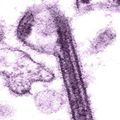Text to go here...
 Scientists have uncovered the Achilles heel of the deadly Ebola virus; the breakthrough could lead to the first treatment for the tropical disease within a decade. Using GM mice, scientists have found that reducing the levels of a key protein results in immunity to infection.
Scientists have uncovered the Achilles heel of the deadly Ebola virus; the breakthrough could lead to the first treatment for the tropical disease within a decade. Using GM mice, scientists have found that reducing the levels of a key protein results in immunity to infection.
Discovered in the Republic of Congo, the Ebola virus is one of the world’s most feared pathogens. Outbreaks can have a devastating effect on all great apes, including humans. The virus is known to weaken blood vessels and prevent blood from clotting. This deadly combination results in the rupturing of blood vessels which the body is then not able to repair, causing death in three out of four cases. Despite 40 years of research scientists have been unable to develop a medicine to combat the disease.
Using human cell lines, researchers screened thousands of genes to find out which ones affected the ability of the virus to enter the cells to cause disease. The screening identified Niemann–Pick C1 (NPC1), a protein involved in cholesterol absorption. It appears that the virus uses this protein to gain entry into host cells, essentially tricking the cell into thinking that the virus is cholesterol. Scientists engineered mice so that they only contained one copy of the NPC1 gene, rather than the normal two, which should lead to lower levels of the protein. These mice were found to be resistant to Ebola infection.
In a separate paper, published at the same time, another team have identified a compound that blocks NPC1, preventing the virus from entering the cell. Although this molecule requires safety tests in animals before human trials can take place, these two breakthroughs give new hope to doctors looking to prevent further deadly outbreaks.
Please also see the AnimalResearch.info page on Ebola vaccine and western gorillas
Last edited: 11 January 2022 14:52




